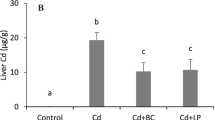Abstract
Lead is a toxic metal present in different concentrations in a wide variety of food products. Exposure to lead, even to low levels, causes acute and chronic toxicities. Lead can cross the blood-brain barrier and accumulate in the nervous system. Probiotics are live microorganisms that, when used in adequate amounts, confer a health benefit on the host. Although a recent study demonstrated that the studied bacteria have a protective effect against acute lead toxicity, no research has been found that shows the long-term impact of these bacteria in vivo. The current study surveyed the protective effects of two species of probiotics, Lactobacillus acidophilus LA-5 and Bifidobacterium lactis BB-12, that are most widely used in many functional foods against oral lead exposure (4 weeks) in rat brains. The results revealed that, at the end of the second week of chronic exposure to lead and probiotic bacteria, the lowest level of lead belonged to the Lactobacillus group. At the end of the fourth week, the lowest amount of lead was related to the group receiving both types of probiotics. With the physiological benefits of probiotic consumption, the bacterial solution in this study did not show high efficacy in reducing brain lead concentrations.

Similar content being viewed by others
Refrences
Agency for Toxic Substances and Disease Registry (ASTDR) (2010) Course: WB 1105. http://www.atsdr.cdc.gov/csem/lead/docs/lead.pdf
Bhakta J, Ohnishi K, Munekage Y, Iwasaki K, Wei M (2012) Characterization of lactic acid bacteria-based probiotics as potential heavy metal sorbents. J Appl Microbiol 112:1193–1206
Canas AI, Cervantes-Amat M, Esteban M, Ruiz-Moraga M, Pérez-Gómez B, Mayor J et al (2014) Blood lead levels in a representative sample of the Spanish adult population: the BIOAMBIENT. ES project. Int J Hyg Envir Heal 217:452–459
Çolak F, Atar N, Yazıcıoğlu D, Olgun A (2011) Biosorption of lead from aqueous solutions by Bacillus strains possessing heavy-metal resistance. Chem Eng J 173:422–428
Collins M, Hrdina P, Whittle E, Singhal R (1982) Lead in blood and brain regions of rats chronically exposed to low doses of the metal. Toxicol Appl Pharmacol 65:314–322
Ferlemi A-V, Avgoustatos D, Kokkosis AG, Protonotarios V, Constantinou C, Margarity M (2014) Lead-induced effects on learning/memory and fear/anxiety are correlated with disturbances in specific cholinesterase isoform activity and redox imbalance in adult brain. Physiol Behav 131:115–122
Halttunen T, Salminen S, Tahvonen R (2007) Rapid removal of lead and cadmium from water by specific lactic acid bacteria. Int J Food Microbiol 114:30–35
Hathout AS, Mohamed SR, El-Nekeety AA, Hassan NS, Aly SE, Abdel-Wahhab MA (2011) Ability of Lactobacillus casei and Lactobacillus reuteri to protect against oxidative stress in rats fed aflatoxins-contaminated diet. Toxicon 58:179–186
Ibrahim F, Halttunen T, Tahvonen R, Salminen S (2006) Probiotic bacteria as potential detoxification tools: assessing their heavy metal binding isotherms. Can J Microbiol 52:877–885
Kinoshita H, Sohma Y, Ohtake F, Ishida M, Kawai Y, Kitazawa H et al (2013) Biosorption of heavy metals by lactic acid bacteria and identification of mercury binding protein. Res Microbiol 164:701–709
Kumar B, Smita K, Flores LC (2013) Plant mediated detoxification of mercury and lead. Arab J Chem, SPECIA L ISSUE: ENVIRONMENTAL CHEMISTRY
Medici M, Vinderola C, Perdigon G (2004) Gut mucosal immunomodulation by probiotic fresh cheese. Int Dairy J 14:611–618
Meng X, Stanton C, Fitzgerald G, Daly C, Ross R (2008) Anhydrobiotics: the challenges of drying probiotic cultures. Food Chem 106:1406–1416
Monachese M, Burton JP, Reid G (2012) Bioremediation and tolerance of humans to heavy metals through microbial processes: a potential role for probiotics? Appl Environ Microbiol 78:6397–6404
Nwokocha CR, Nwokocha MI, Aneto I, Obi J, Udekweleze DC, Olatunde B et al (2012) Comparative analysis on the effect of Lycopersicon esculentum (tomato) in reducing cadmium, mercury and lead accumulation in liver. Food Chem Toxicol 50:2070–2073
Saarela M, Mogensen G, Fondén R, Mättö J, Mattila-Sandholm T (2000) Probiotic bacteria: safety, functional and technological properties. J Biotechnol 84:197–215
Teemu H, Seppo S, Jussi M, Raija T, Kalle L (2008) Reversible surface binding of cadmium and lead by lactic acid and bifidobacteria. Int J Food Microbiol 125:170–175
Toscano CD, Guilarte TR (2005) Lead neurotoxicity: from exposure to molecular effects. Brain Res Rev 49:529–554
WHO (2011) Lead in drinking-water. Background document for development of WHO guidline for drinking-water quality.http://www.who.int/water_sanitation_health/dwq/chemicals/lead.pdf
Xu Y, Wang Y, Zhao M, Hou B, Peng L, Zheng M et al (2011) Lead detoxification activities and ADMET hepatotoxicities of a class of novel 5-(1-carbonyl-L-amino-acid)-2, 2-dimethyl-[1, 3] dithiolane-4-carboxylic acids. Bioorg Med Chem Lett 21:1754–1757
Zhai Q, Wang G, Zhao J, Liu X, Tian F, Zhang H et al (2013) Protective effects of Lactobacillus plantarum CCFM8610 against acute cadmium toxicity in mice. Appl Environ Microbiol 79:1508–1515
Acknowledgments
This paper was extracted from a MSc. thesis at Zanjan University of Medical Sciences. The researchers highly appreciate the cooperation of the Research Council of Zanjan University of Medical Sciences for financial supports. They also want to express their gratitude for the kind cooperation of all those who assisted in this research.
Author information
Authors and Affiliations
Corresponding author
Additional information
Responsible Editor: Philippe Garrigues
Rights and permissions
About this article
Cite this article
Zanjani, S.Y., Eskandari, M.R., Kamali, K. et al. The effect of probiotic bacteria (Lactobacillus acidophilus and Bifidobacterium lactis) on the accumulation of lead in rat brains. Environ Sci Pollut Res 24, 1700–1705 (2017). https://doi.org/10.1007/s11356-016-7946-9
Received:
Accepted:
Published:
Issue Date:
DOI: https://doi.org/10.1007/s11356-016-7946-9




